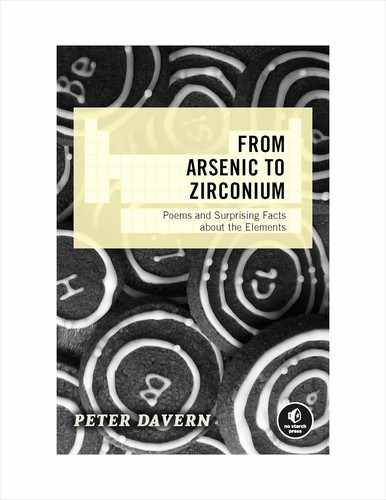Footnotes
ARSENIC, As
1: A fluorine gas concentration of only 0.1 percent will prove fatal if inhaled for even just a few minutes!
2: J. Environ. Monit., 2005, 7, 11–15.
TECHNETIUM, Tc
3: Deuterons are nuclei of deuterium, the isotope of hydrogen containing one proton and one neutron in its nucleus.
4: Via the spontaneous fission of uranium ores.
TELLURIUM, Te
5: Aqua regia, from the Latin for royal water, is a highly corrosive, fuming, yellow/red mixture of nitric acid and hydrochloric acid (1:3) capable of dissolving most metals, including gold.
6: The middle of the periodic table as it’s normally presented, that is, with the lanthanoid and actinoid rows displayed beneath the main body of the table.
7: Something similar happens with argon (39.95) and potassium (39.098).
IRIDIUM, Ir
8: When heated sufficiently, most solids initially melt to form a liquid and then boil to produce a gas or vapor. By contrast, some solids sublime when heated, meaning that they bypass the liquid phase entirely and transform directly to a gas/vapor.
9: Jacob Marinsky (1918–2005), Lawrence Glendenin (1918–2008), and Charles Coryell (1912–1971)
10: neodymium-iron-boron (see “Neodymium, Nd” on page 176 for more details)
11: Only picograms (pg, 10–12 g) of promethium exist in nature, at best! (See “Promethium, Pm” on page 178.)
12: Journal of the American Chemical Society, 1911, 33 (8), 1332–1344.
13: Europium’s and ytterbium’s atoms are exceptions due to their tendency to adopt a +2 oxidation state (Eu2+ and Yb2+) in addition to the +3 state adopted by all the lanthanoids.
14: At around 0.5 parts per billion (ppb), rhenium is only the 77th most abundant element in Earth’s crust.
15: With a density of 21.0 g/cm3, rhenium is the fourth-densest element after osmium, iridium, and platinum.
16: Spectrochimica Acta Part B: Atomic Spectroscopy 59, no. 8 (August 31, 2004): 1305-1310. doi:10.1016/j.sab.2003.12.027.
17: Osmium is the 81st most abundant element on the planet, accounting for only about 1 part per billion (ppb) of Earth’s crust.
18: Bureau International des Poids et Mesures (BIPM)
19: The second is defined with respect to a particular hyperfine splitting frequency of the cesium atom (see “Cesium, Cs” on page 162 for more information).
PLATINUM, Pt
20: Earth’s crust contains only about 1 part per billion (ppb) of platinum, making it only the 75th most abundant element.
21: cis-dichlorodiamminoplatinum(II), PtCl2(NH3)2
ACTINIUM, Ac
22: It’s only the 73rd most abundant element in Earth’s crust.
23: Here, room temperature implies the temperature prevailing in temperate climates. But in slightly warmer regions, don’t be surprised to see two other metals, cesium (melting point = 28°C) and gallium (melting point = 29.8°C), in liquid form as well. On scorching hot days, rubidium (melting point = 39°C) also obliges!
24: Mercury is so dense (some 13.5 times denser than water) that you would sink no more than a few inches if you plunged headlong into a bathtub full of the element, although doing so is not recommended—see the last line of the poem to find out why!
25: Its hourly evaporation rate is 800 mg/m2 of liquid surface.
26: Astatine-211 has a half-life of only 7.2 hours.
27: At the end of 2015, element 118 was formally recognized (along with elements 113, 115, and 117) by the International Union of Pure and Applied Chemistry (IUPAC). Subsequently named oganesson (symbol: Og), its position in group 18 directly below radon means it might behave like a noble gas. But this is challenging to confirm due to its fleeting half-life of only 0.89 ms. Also, if estimates of its boiling point (around 50°C) prove correct, then oganesson might turn out to be a noble liquid instead!
28: This was uranium ore from which the uranium had previously been extracted for commercial use in ceramic glazes. The radium that remained was slightly more concentrated as a result, although it was still very much a trace impurity.
29: Formerly known as the actinides
THORIUM, Th
30: Thorium decays via the emission of alpha particles.
THE TRANSURANIUM (TRANSURANIC) ELEMENTS
31: Protactinium-234’s half-life is just under 6.75 hours.
32: Strictly speaking, neptunium (Np, atomic number 93), plutonium (Pu, 94), and berkelium (Bk, 97) are naturally occurring transuranic elements. But they occur in such trace amounts that they were only discovered in nature after they had first been artificially made.
33: For more information on oganesson, see “Radon, Rn” on page 250.
